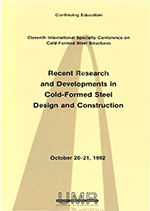Location
Saint Louis, Missouri
Session Dates
20 Oct 1992
Abstract
Thin-walled lip-stiffened channel columns composed of high strength steel may fail in a distortional mode involving movement of the lip stiffener perpendicular to the flange plate it supports. In this report, test results for a simple lipped channel section(CH1) and an intermediate stiffened channel section (CH2) of thickness of approximately 1.1 mm (0.043 in) and 550 MPa (79.8 ksi) steel and undergoing distortional or mixed local-distortional buckling failure are compared with different design methods. The design methods compared are Australian Standard AS1538, EC3 Partl/ Annexe A, the ECCS Recommendations and the AISI Specification. In addition, new methods based on a modified Winter formula for effective width are presented and compared with the tests.
Department(s)
Civil, Architectural and Environmental Engineering
Research Center/Lab(s)
Wei-Wen Yu Center for Cold-Formed Steel Structures
Meeting Name
11th International Specialty Conference on Cold-Formed Steel Structures
Publisher
University of Missouri--Rolla
Document Version
Final Version
Rights
© 1992 University of Missouri--Rolla, All rights reserved.
Document Type
Article - Conference proceedings
File Type
text
Language
English
Recommended Citation
Kwon, Y. B. and Hancock, Gregory J., "Design of Channels Against Distortional Buckling" (1992). CCFSS Proceedings of International Specialty Conference on Cold-Formed Steel Structures (1971 - 2018). 1.
https://scholarsmine.mst.edu/isccss/11iccfss/11iccfss-session6/1
Design of Channels Against Distortional Buckling
Saint Louis, Missouri
Thin-walled lip-stiffened channel columns composed of high strength steel may fail in a distortional mode involving movement of the lip stiffener perpendicular to the flange plate it supports. In this report, test results for a simple lipped channel section(CH1) and an intermediate stiffened channel section (CH2) of thickness of approximately 1.1 mm (0.043 in) and 550 MPa (79.8 ksi) steel and undergoing distortional or mixed local-distortional buckling failure are compared with different design methods. The design methods compared are Australian Standard AS1538, EC3 Partl/ Annexe A, the ECCS Recommendations and the AISI Specification. In addition, new methods based on a modified Winter formula for effective width are presented and compared with the tests.



